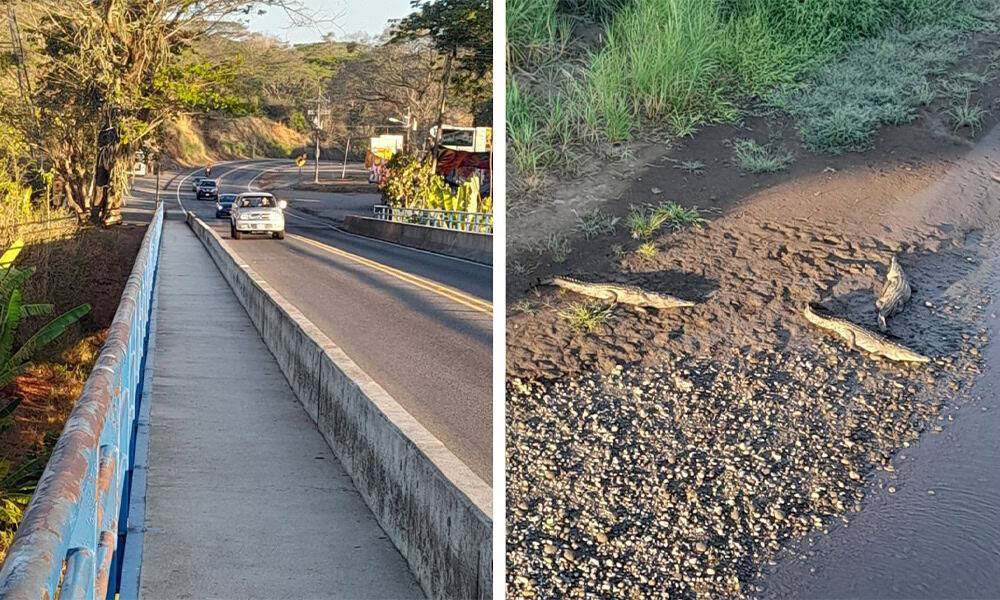‘Who’s letting me do this?’ is the best way to describe one of the best aspects of living in Costa Rica. You find yourself in a situation that’s the right combination of exciting and unsettling and that very question flashes through your mind.
During the exploratory expedition that my wife and I took to Costa Rica over twelve years ago, we hopped into our little rental car and set off south from the Central Valley to visit Carara National Park. Along the way down the coastal highway, traffic slowed to a crawl just before we reached a bridge near the town of Tárcoles.
Being the young, free people we were at that time, we decided to pullover and see what all of the fuss was about. We parked the car, walked past all of the food and souvenir vendors, and followed the throng of other tourists out onto the bridge.
At the halfway point of the bridge, we peered down to see a pile of truly enormous crocodiles gathered below in the bridge’s shadow. The sight of such massive wild predators was more than enough to get my blood pumping. Just then, a tractor trailer thundered past us avoiding a pothole just feet from our little sidewalk causing me to grab onto the barely waist-high railing which was the only thing stopping me from falling into the open jaws of a large reptile. I immediately thought, ‘Who’s letting me do this?’
That was my first experience on Costa Rica’s famous crocodile bridge and, I’m not going to lie, I loved it just as much as the next guy. As the years progressed and I worked more with wildlife and learned more about the ins and outs of human/wildlife interactions, my thoughts on the crocodile bridge evolved. My current view is that, just like much in life, the croc bridge isn’t a purely good or bad thing, but a jumbled-up combination of both.
The Crocodile Bridge is Awesome
The crocodile bridge is awesome because it’s a free opportunity to get a clear view of huge American crocodiles in their native habitat. At any age in my wildlife-loving life, my heart would have soared at the sight of so many crocodiles. What better way is there to encourage interest in wildlife and conservation than displaying epic individuals of charismatic megafauna for all to see?
There’s also the economic factor to consider. I walked by a whole host of vendors on my way to gaze at those crocodiles. On the short trip from my car to the crocs and back, I could have bought a meal, a t-shirt, and totally real (definitely fake) crocodile tooth necklace, all before tipping the car-watcher guy and carrying on my way.
For those that want a closer look, there are several tour boat operators that will happily sell you a croc tour. I found a thesis of a grad student who studied the economic impact on the local economy in 2014, which estimated that tourists spent over 5 million dollars in that year alone at the bridge.
The Crocodile Bridge is a Bad Idea
The crocodile bridge is a bad idea because all of those crocodiles shouldn’t be there. The reason that so many giant crocodiles are basking in the sun below that bridge is because people have been feeding them for years. Tour boat operators thrill their guests by making the crocs lash out for a chunk of chicken and anybody who benefits from the crocodiles’ presence can toss a fish off of the bridge itself.
The purposeful feeding of large predators is pretty much universally regarded as a bad idea. Animals that receive food from people can easily become more aggressive towards any people that they see because they’re accustomed to being fed. I’m sure you could find a seasoned tour boat operator that could tell you he’s perfectly safe feeding the crocodiles that he knows, but do you want to know what’s even safer for him and everybody else? Not doing it at all.
There was also a study published in 2011 that captured a few of the Tárcoles bridge crocodiles and documented that some had injury-induced eye trauma that was likely the result of males fighting for dominance in the overpopulated area around the bridge. So bringing that many crocodiles together for the benefit of people could be to the detriment of the animals themselves.
So there you have it. The famous Costa Rica crocodile bridge is both a good and bad thing. I think I know where I stand. What do you think?
About the Author
Vincent Losasso, founder of Guanacaste Wildlife Monitoring, is a biologist who works with camera traps throughout Costa Rica.






